Sixers Season Preview: 10 Pressing Questions About the 2015-16 Philadelphia 76ers
Editor’s note: This blog was originally launched as Sixers 24/7, an homage to our popular Eagles channel Birds 24/7. Shortly after launching, a long-running private Facebook group and passionate fan outpost called Sixers 24-7 was brought to our attention. Out of respect to the community there, we’ve changed the name of our Sixers channel to Sixers Post.
Before we get started I’d like to take a moment to formally introduce Sixers Post, the new Philadelphia 76ers blog here at Philadelphia magazine.
A little bit of quick information about myself. I’ve previously covered the 76ers for SB Nation’s 76ers blog LibertyBallers and 97.3 FM, South Jersey’s ESPN radio affiliate. I also cover the NBA draft for DraftExpress.com and USA Today. And earlier this year, I covered the Sixers’ draft here at Sixers Draftland.
I’m excited to have the opportunity to try to build something unique and informative here at Philly Mag, much in the same way Sheil and Tim did with the Birds 24/7 a few years back. The coverage is going to be a combination of access to the team and original reporting, along with film breakdowns, statistical analysis, and deep dives into the NBA’s Collective Bargaining Agreement.
As strange as it is to say, this is an exciting time to be a Philadelphia 76ers fan. They’re building something, or at least trying to. The front office has taken an incredibly focused approach to chase superstars. It may or may not work out, no rebuild is sure-fire, but in a sport dominated by superstars, and in a town that has been so lacking in that regard for so long, it’s going to be exciting to watch that process play out.
And that process has already started to show progress, even if it hasn’t yet been reflected in wins and losses. Brett Brown is starting to establish an identity with this team. Nerlens Noel looks poised to have a breakout year. Jahlil Okafor is incredibly talented. Joel Embiid, if he’s ever able to get back on the court, may be the most talented of them all. Add in Dario Saric and two potential top-10 picks in the 2016 draft (and four first round picks in total) and you’re starting to see the potential upside.
So stick around, let’s follow that development together, and debate about the progress in the comments section.
With that out of the way, let’s take a look at some of the most pressing questions surrounding the 76ers as they head into year three of the Sam Hinkie and Brett Brown era.
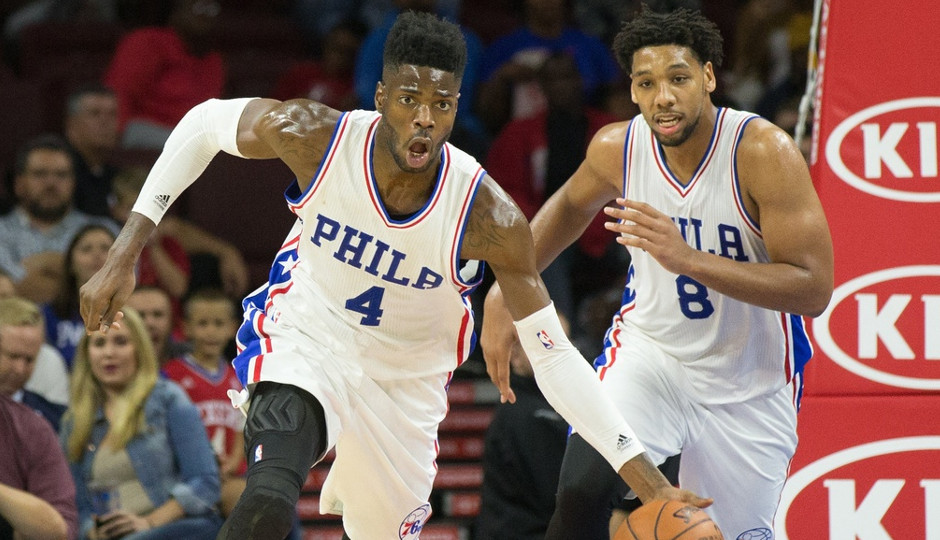
Nerlens Noel (4) and Jahlil Okafor (8) are key pieces in the Sixers’ rebuild | Bill Streicher-USA TODAY Sports
1. Can Nerlens Noel and Jahlil Okafor play together?
Sam Hinkie has now used five lottery picks during his brief tenure with the Sixers (if you include the draft-day trade to acquire Nerlens Noel), and four of them have been on big men: Nerlens Noel, Joel Embiid, Dario Saric and Jahlil Okafor.
Embiid and Saric are mostly out of sight, out of mind. Embiid is not expected to play this season, which means he will not play in either of his first two seasons as he recovers from a stress fracture in the navicular bone in his right foot. Saric will play at least another season for his Turkish club, Anadolu Efes, before he has a buyout which would enable to come over to the NBA.
That leaves Okafor and Noel as contributors this season, and whether or not they can play on the court together will be one of the biggest question marks the Sixers hope to answer this season.
Early returns have been positive so far this preseason. Noel’s incredible defensive versatility makes this pairing viable, as he has the ability to stick with more perimeter-oriented power forwards and cause havoc defending the pick-and-roll, but also the quickness and the rim protection to get back into the paint and alter shots. So far this preseason Noel has averaged three steals and one block per game, to go along with 6.8 defensive rebounds per night in his limited time. His production, especially considering he’s playing more on the perimeter defensively, has been outstanding.
The bigger question has been on the offensive side of the court. Both of the big men are good passers for their position, which helps quite a bit. Noel’s improved comfort creating off the dribble also makes it harder for his defender to leave him and double down on Okafor in the post. The question about floor spacing is still present, however. The NBA has increasingly become focused on spacing over the past decade, and neither Noel or Okafor have shown consistent range beyond 10 feet. The progress Noel has made from the free-throw line gives hope, but there’s still improvement that needs to be made.
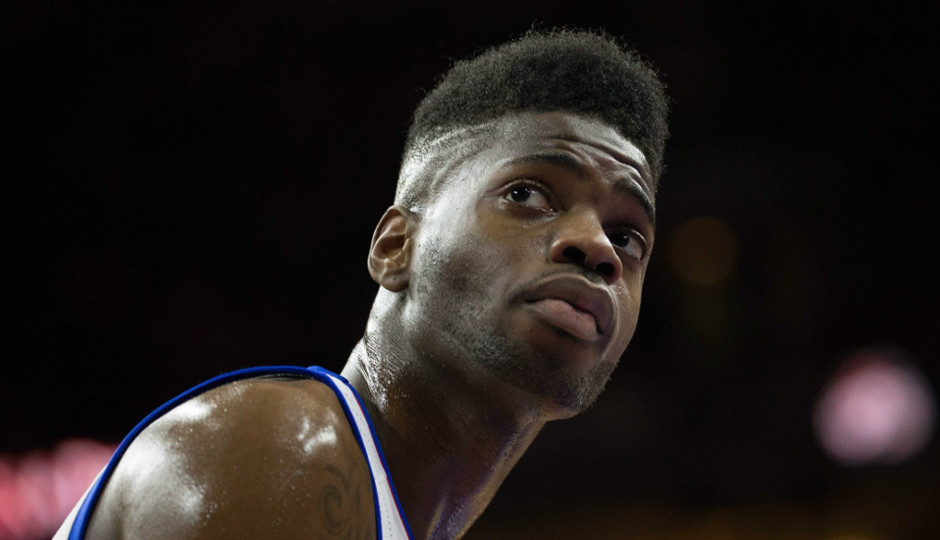
Photo | Bill Streicher-USA TODAY Sports
2. What is Nerlens Noel’s upside?
Noel was projected by most to be the No. 1 pick in the 2013 NBA draft before teams got scared off by the amount of time he’d miss recovering from a torn anterior cruciate ligament. This has turned out to be a major mistake. Anthony Bennett, the No. 1 overall pick in the draft has already been traded and waived in his short NBA career, while Noel has turned into a legitimate defensive force. Immediacy is not always the correct preference.
Noel’s draft projection was based mostly on his unique — and potentially dominant — defensive toolset, and that has translated to the NBA game about as well as anybody could have hoped for. Noel was among the league leaders last season in defensive win shares (4.2, tied for 10th) and defensive box plus/minus (4.5, 8th), a virtually unprecedented accomplishment for a 20-year-old rookie. There was nobody in the top-20 of either statistic as young as Noel was last season.
Noel’s impact on the team’s defensive success was just as profound. Without Noel on the court the Sixers gave up 107.7 points per 100 possessions, which would rank 25th in the league, and falls in line with the Sixers 26th ranking in defensive rating during the 2013-14 campaign. With Noel on the court that defensive rating fell to 103.1, which would be the 6th best mark in the league. It’s the kind of defensive impact that 20-year-old rookies aren’t supposed to have.
The question becomes how much more can Noel improve? Considering the incredible improvement Noel showed between the first half of his rookie season (8.2 points, 7.2 rebounds, 46.7% true shooting percentage before the break) to the second half of the year (13.1 points, 10.0 rebounds, 52.8% true shooting percentage), to how he’s looked in the preseason (13.3 points, 8.5 rebounds, 53.6% true shooting percentage, it’s hard to put an upper limit on his potential. Noel has such a rare combination of elite athleticism and incredible reflexes, along with such a drastic rate of improvement so far in his career, he may have significantly more potential, even offensively, than originally assumed.
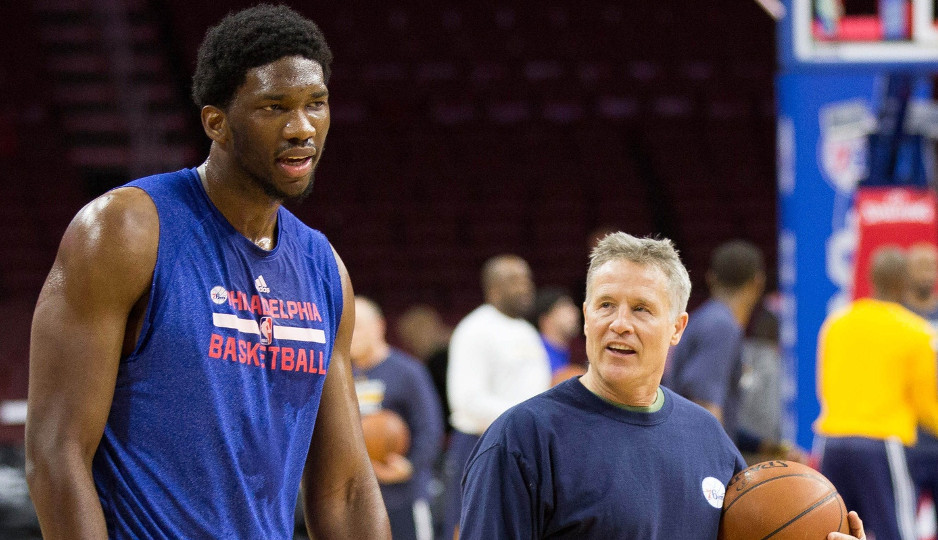
Sixers head coach Brett Brown works with Joel Embiid before the Sixers played the Indiana Pacers last season at the Wells Fargo Center | Bill Streicher-USA TODAY Sports
3. Will Joel Embiid return?
This is a question that is unlikely to be answered this season. Even if Joel Embiid were able to play at the start of next season, no Sixers fan is going to feel really confident in his foot holding up until years have gone by without another setback.
Such a turnaround, even after missing two full seasons, wouldn’t be completely unprecedented. Cleveland Cavalier big man Zydrunas Ilgauskas was able to enjoy a relatively healthy career — after having the same bone graft procedure to repair the same navicular bone fracture — that Embiid just went through. But Embiid’s status is a huge question mark going forward, and his health is something that few will count on. Which is a shame, because Embiid has the kind of talent to truly turn this franchise around — if he’s ever able to stay healthy.
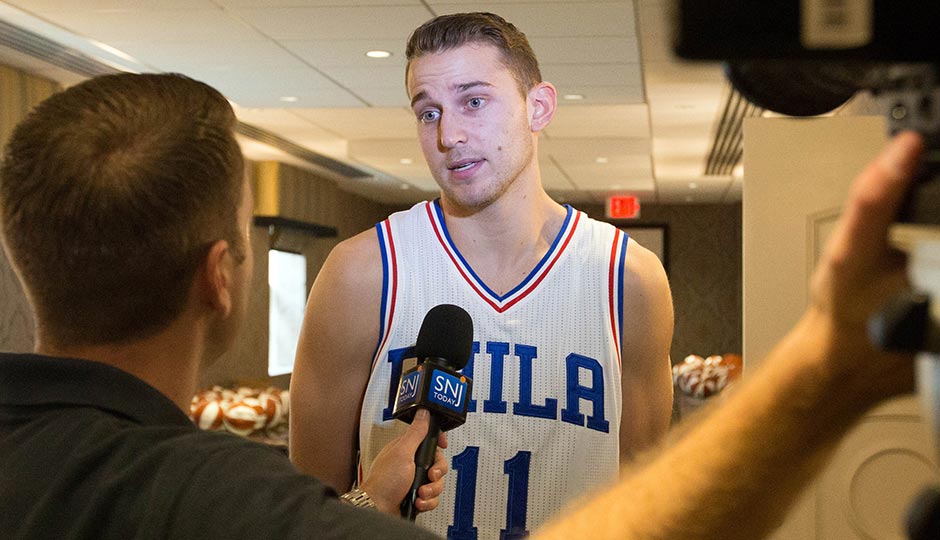
Philadelphia 76ers guard Nik Stauskas (11) talks with the media during media day at Stockton Seaview Hotel. Photo | Bill Streicher-USA TODAY Sports
4. Can Nik Stauskas return to the form that made him the 8th pick in the draft?
Nik Stauskas averaged 17.5 points, 2.9 rebounds, and 3.3 assists per game during his sophomore season at Michigan, shooting 47% from the field and 44.2% from the three-point line, production which earned him the Big Ten Player of the Year Award and an 8th overall selection in the 2014 NBA draft.
That success didn’t translate immediately to the NBA, as Stauskas capped off a disappointing rookie season with the Kings with averages of 4.4 points in 15.4 minutes per game, shooting a dismal 36.5% from the field and 32.2% from three-point range. Stauskas was disappointing enough that the Kings were willing to include him, along with pick swaps the next two seasons and a future first round pick, to dump the contracts of Carl Landry and Jason Thompson onto the Sixers.
There is some hope that Stauskas can thrive after adjusting to the NBA, however. Stauskas averaged a much more respectable 6.6 points per game on 41.8% from the field, including 42.1% from three-point range, after the All-Star break. He then followed that up by averaging 12.9 points, 3.9 rebounds, and 3.1 assists per game for the Canadian national team in the FIBA Americas tournament, shooting 51.5% from the field and 50% from three-point range.
Stauskas suffered a right tibia stress reaction early on in training camp this fall and hasn’t been able to play in the preseason so far. He could start off slow as he gets himself back into game shape, but Stauskas has more athleticism and ability to create out of a pick-and-roll than most pure shooters do, and could be primed for a bit of a bounce-back year.
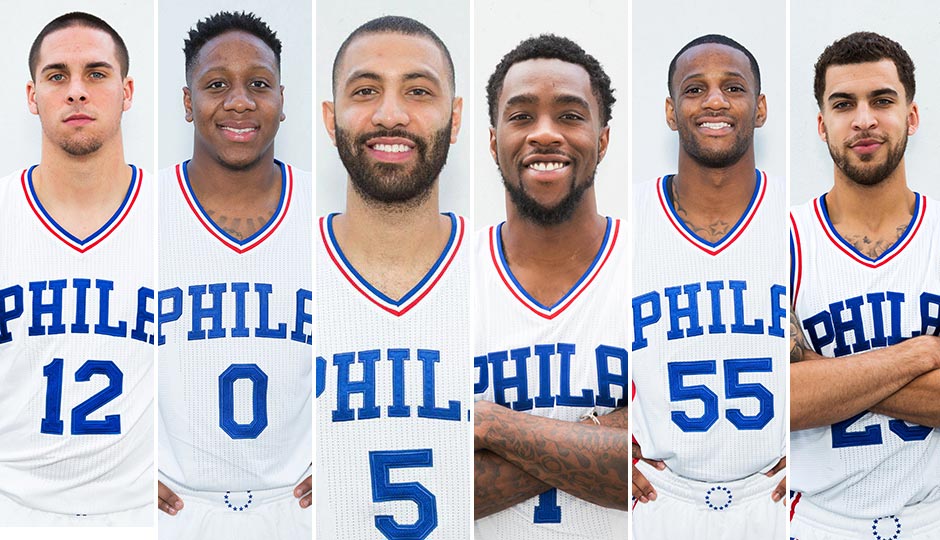
Who will win the 76ers point guard lottery? The candidates, from left, T.J. McConnell, Isaiah Canaan, Kendall Marshall, Tony Wroten, Pierre Jackson and Scottie Wilbekin. Photos | Bill Streicher, USA Today Sports
5. Who will play point guard for the Sixers?
Entering training camp, Sixers head coach Brett Brown called this the team’s greatest question, and few answers were provided during preseason play.
Tony Wroten and Kendall Marshall, who have the most experience of the six point guards the Sixers had in camp, are both still a ways away from returning from surgeries they had to repair torn ACLs last winter. The rest of the group — Isaiah Canaan, T.J. McConnell, Scottie Wilbekin, and Pierre Jackson — have struggled to separate themselves thus far.
Canaan’s three-point shot is the most identifiable NBA skill among this group, even if he’s struggled to connect at a high level during the preseason. Canaan shot 36.4% from three-point range on more than seven three-point attempts per game after being acquired from Houston last year.
That jump shot might give Canaan the leg up to win the third point guard spot coming out of preseason, which would guarantee him a roster spot, and a likely starting position on opening night. Brett Brown said before the season that they expected to carry three of the six point guards on their regular season roster, but with Wroten and Marshall both out there may be room for a fourth. If so, Arizona’s T.J. McConnell has played the best in preseason, and his ability to press the ball defensively and set up his teammates could prove valuable.
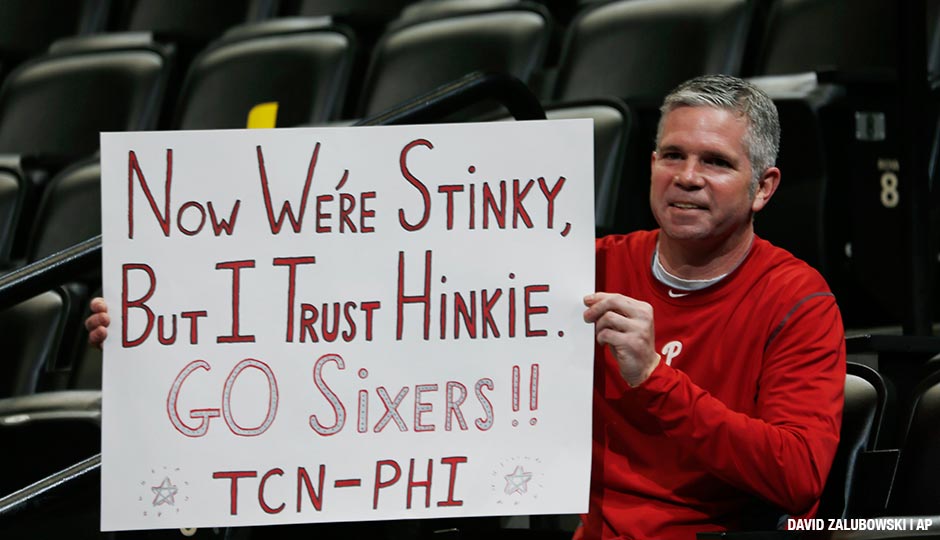
Philadelphia 76ers fan and Bucks County, Pa., native Andy Atkinson, who now lives in Denver, waves a placard in support of 76ers general manager Sam Hinkie’s rebuilding effort as the Sixers take the court to face the Denver Nuggets in the first quarter of an NBA basketball game Wednesday, March 25, 2015, in Denver.
6. Will the Sixers make a trade of significance at this season’s trade deadline?
Sixers general manager Sam Hinkie has guided the team through two trade deadlines during his short tenure. He used the 2013 deadline to ship off Evan Turner and Spencer Hawes, getting draft picks for players who didn’t factor into the long-term future of the team. He then used the 2014 deadline to get the Lakers’ (likely 2016) pick for Michael Carter-Williams. Both years the team took on salary to reach the salary cap floor, and also acquire additional draft picks in the process.
Eventually the team is likely to push some of these assets they’ve been collecting to the center of the table in a trade to acquire a marquee player, similar to what Houston did when they acquired James Harden back in 2012. The Harden trade is a little bit unrealistic to expect duplicated, as young franchise guys rarely become available. But if one of the young players the Sixers have been developing proves that they can be a focal point of the team going forward, the Sixers could then look to accelerate the rebuild and find a complimentary star through trade. My guess is that happens sometime in the next 12 months.
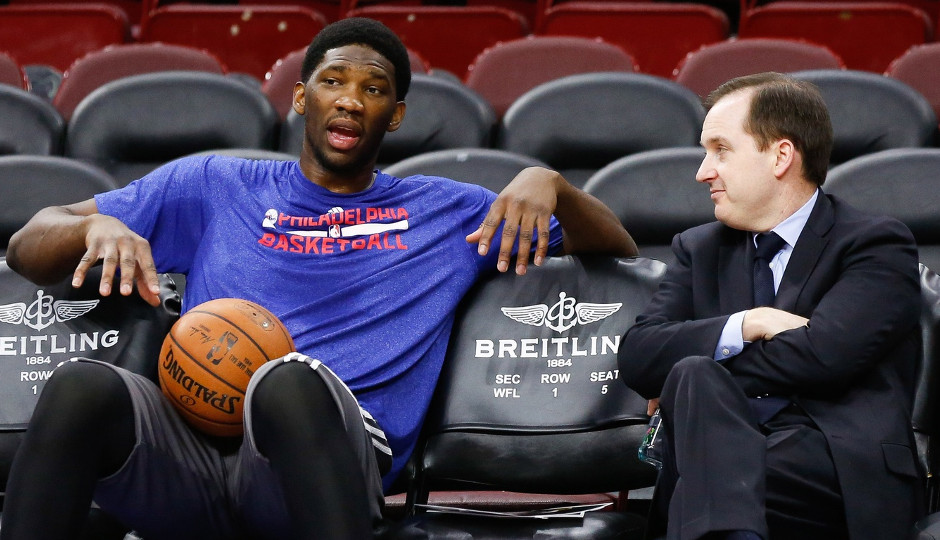
Sixers general manager Sam Hinkie talks with Joel Embiid before a game last season | Bill Streicher-USA TODAY Sports
7. What draft picks will the Sixers have in the 2016 draft?
A lot!
The Sixers currently have the right to swap their own first round pick with the Sacramento Kings pick. They will get the Lakers pick as long as it doesn’t land in the top 3, Miami’s pick as long as it doesn’t land in the top 10, and Oklahoma City’s pick as long as it doesn’t land in the top 15. They also have the right to swap either the Heat’s pick or the Thunder’s pick for the Warriors pick if such a swap would favor the Sixers.
That means the Sixers have a very good chance of having four first round draft picks in June’s draft. Miami, with Chris Bosh back and Goran Dragic integrated into the offense should be a playoff team in the East, even with their age and injury concerns. The Thunder pick will convey as long as they have even the slightest bit of injury luck. The biggest question may come down to the Lakers pick. The Lakers should be bad this year, and the Sixers could fall prey to some bad lottery luck next May, but even here the Sixers have a very good chance of having this pick convey to them.
If I had to guess:
- Sixers pick, #4 overall (does not swap with Sacramento)
- Lakers pick, #7 overall
- Heat pick: #19 overall (does not swap with Golden State)
- Thunder pick: #25 overall (does not swap with Golden State)

Robert Covington and Tim Frazier celebrate | John Geliebter-USA TODAY Sports
8. How much potential does Robert Covington have?
One of the pleasant surprises for last year’s Sixers team was Robert Covington.
Covington attempted 6.4 three-point attempts per game last season, the 6th most in the league. Of those who attempted more than that only The Splash Brothers in Golden State, Stephen Curry and Klay Thompson, did so at a significantly higher rate of effectiveness than Covington’s 37.4%.
That effectiveness was even more amazing when you consider how infrequently Covington was able to get open looks. Nearly 75% of Covington’s catch and shoot field goal attempts last season were contested, an incredibly high rate. Covington shot 44.8% on three-point attempts “very early” in the short clock (between 22 and 18 seconds remaining), which were mostly transition attempts, one of the few areas where Covington was able to get an open look at the basket. He shot 44.8% from three-point range when he was wide open, which is defined as not having a defender within 6 feet of the shooter.
If the Sixers can get Covington more open looks, he could be an even more effective three-point shooter. A post scorer who can command a double team is one of the easiest ways to get an open three-point shot, and Okafor, these Sixers’ first player who can legitimately command a double team in the half-court, could do wonders for Covington’s game.
Besides getting more open shots, Covington has been a more well-rounded player so far this preseason. He’s rebounding better (17.2% defensive rebounding rate, compared to 14.5%), passing more (15.9% assist percentage, up from 9.5%), and creating more off the dribble.
Raising his scoring average to 15 points per game, while doing so more efficiently than last season, could be in the cards for Covington this season, provided the right knee sprain he suffered in Friday’s preseason finale isn’t serious.
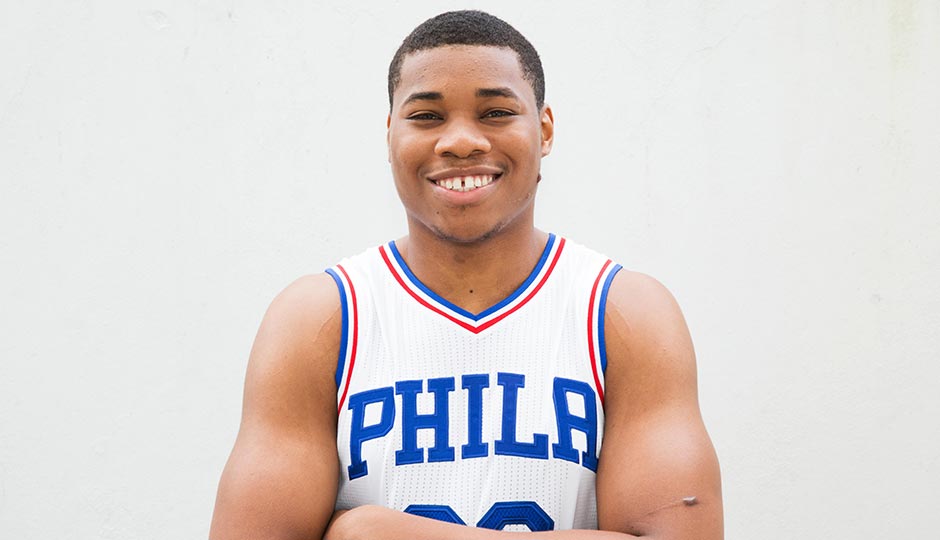
Richaun Holmes. Photo | Bill Streicher
9. Is Richaun Holmes a legitimate backup big man?
Despite winning the MAC’s Defensive Player of the Year and making the All-Conference 1st team, Richaun Holmes was flying under the radar through the early part of the draft process. That happens when you play at Bowling Green.
Then Holmes went to the Portsmouth Invitational Tournament, measured just under 6’9″ in socks, with a 9′ standing reach and a 34″ no-step vertical jump, a great combination of physical tools for a big man. On top of that Holmes looked like a man among boys, averaging 14.7 points, 7.7 rebounds, and 3.7 blocks per game at the tournament. He started climbing up draft boards immediately.
Holmes has a combination of skills that makes him easy to fit with just about any front court rotation. He can block shots at the rim, clean up the defensive glass, has the size and strength to bang down low, and can step out on the perimeter and hit three-point shots offensively. He has the makings of a good role player down the line.
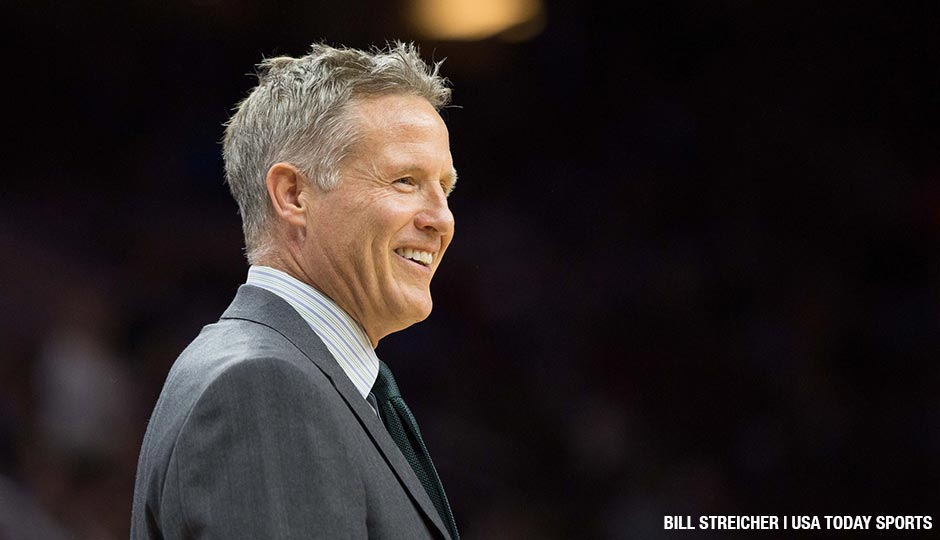
Philadelphia 76ers head coach Brett Brown smiles as time winds down in the second half of a March game against the Sacramento Kings.
10. Can Brett Brown keep the team near the top-10 defensively?
One of the key takeaways from last season was how Brett Brown (with a huge assist from Nerlens Noel) improved the Sixers defense, climbing from 26th in the league defensively to 13th. In the process the Sixers established a legitimate team identity.
Building on that improvement, or even maintaining it, could be a tough task for Brown and the Sixers this season. Brown and his staff will have to integrate some players not particularly known for their defense, and the drop off from Luc Mbah a Moute, K.J. McDaniels, and Michael Carter-Williams to Jahlil Okafor, Nik Stauskas, and Kendall Marshall is going to be a tough one to overcome on the defensive side of the court.
There is some hope, though, and a lot of it rests on Nerlens Noel’s slender shoulders. When Noel played next to Henry Sims, who was not exactly the most mobile and active defender, the Sixers’ defense actually improved, and they held teams to a true shooting percentage of 48.5%. This gives hope that Noel is such a fantastically unique defensive player that the Okafor and Noel pairing can work defensively.
The Sixers defense could also be improved by simply turning the ball over less frequently. The Sixers committed the most turnovers in the league last season. Despite playing pretty good transition defense, the sheer amount of time the Sixers turned the ball over caused them to give up the 6th most transition points in the league. Improving on this would help their defensive numbers immensely.
Derek Bodner covers the 76ers for Philadelphia magazine’s new Sixers Post. Follow @DerekBodnerNBA on Twitter.


